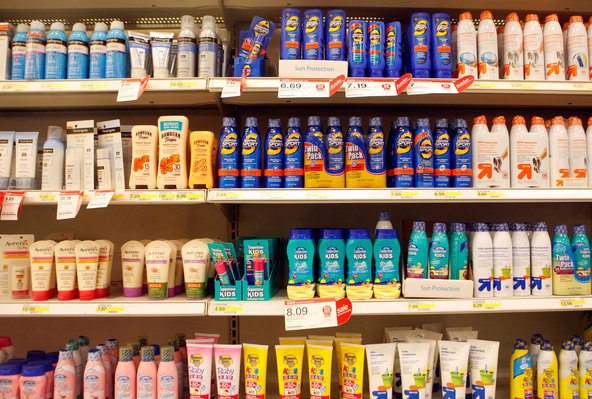
I can remember, like it was yesterday, stepping from the car as a new bride, to the unfamiliar frontier that was to be my home. Somewhere between the vows and the wedding cake, the man at my side neglected to mention he was moving me to the equator – a hop, skip, and a jump from the sun – one zip code from hell. It’s a good job the house has storage buildings for me to shelter in when I was working outside.
In reality it was South Florida.
With my reaction, my husband could only muster, “It’s only May. August will prove a real problem for you.”
He wasn’t wrong. I love hockey, cold weather, St. Bernard’s, and snow. Did I mention hockey?
In the years since my arrival, I have graciously bloomed where I was planted and am forever grateful to Vincent Viola for keeping the Panthers in Florida, where they belong. After reading Palm Beach Post Staff Writer Susan Salisbury’s article on problems with today’s sunscreen’s, however, I believe I may have a bigger problem than heat and hockey.
According to the article and the Environmental Working Group (EWG) Sunscreen Guide for 2015 – the 9th annual edition – an analysis of 1,700 sunscreens found that 80% contained harmful ingredients. What was more, they don’t protect adequately against dangerous ultraviolet radiation.
The active ingredients in sunscreens come in two forms, mineral and chemical. Each uses a different mechanism for protecting skin and maintaining stability in sunlight, and each can pose hazards to human health. The most popular sunscreens on the market today, contain a combination of two to six of the following active ingredients: oxybenzone, avobenzone, octisalate, octocrylene, homosalate, and octinoxate. (Obviously, these chemicals are not meant to be ingested). Mineral sunscreens, on the other hand, use zinc oxide and/or titanium dioxide.
To accurately tabulate human exposure and toxicity information, the FDA asks certain questions. Among those are:
* Will the chemical penetrate skin and reach living tissue?
* Will it disrupt the hormone system?
* Can it cause a skin allergy?
* What if it is inhaled?
Nearly every chemical sunscreen in the United States contain avobenzone because it is the best available for use against damaging UVA rays. It does, however, breakdown when exposed to sunlight and must be stabilized with other chemicals, such as octocrylene.
The frequently used and worrisome oxybenzone was found to act like estrogen in the body, while it alters sperm production in animals, and is associated with endometriosis in women, as well as causing relatively high rates of skin allergy.
As for protection, for those of you who chose a sunscreen by perusing the aisles of your local drugstores, in search of a product with the highest SPF number – keep reading.
Sonya Lunder, Senior Analyst with the EWG said that, “The SPF (sun protection factor) value tells you how strong the sunburn protection is. There are also UVA rays from the sun which cause more subtle skin damage. As the SPF goes up higher, you do not get more UVA protection. It maxes out at 20.”
The FDA has proposed prohibiting the sale of sunscreens with SPF values greater than 50+, calling higher SPF values “inherently misleading,” but it has not issued a regulation that carries the force of the law. Twelve percent of sunscreens they evaluated this year advertise SPF greater than 50+.
What’s more, it’s been found that the common sunscreen additive, vitamin A, may speed development of skin cancer! Vitamin A is added to 19% of beach and sport sunscreens and 17% of moisturizers.
So, which products made it to this years EWG’s SUNSCREEN HALL OF SHAME? As you can guess, there were numerous.
The number one stand out was my favorite – Neutrogena. EWG states while its Pure and Free Baby claims to be chemical free, its label begs to differ.
Neutrogena is also pegged with boasting sky-high SPF values (which is most likely why I purchased it) 70-100%. Their Wet Skin Kids Sunscreen Spray also had several strikes against it.
Banana Boat, And Coppertone also scored poorly. CVS, the pharmacy/store, had 3 of their products listed in the top 12 worst sunscreen lotions, and 4 listed in the top 11 sprays.
Now that we are armed with this newfound knowledge and are aware of the shortcomings of today’s sunscreens, what are sun-worshipers and those of us living down the road from the sun to do? The EWG suggests that we adjust our attitudes about sun exposure.
1. Don’t use sunscreen as a tool to prolong your time in the sun.
2. Cover up! Shirts, hats, sunglasses. (Hazmat suits on aisle three)
3. Avoid sunburn. (This is why they get the big bucks.)
4. Avoid tanning beds. (Does anyone still do that?)
5. Protect kids from the hot sun! (Hide your women and children!)
6. Check your skin. (Move in with a dermatologist.)
As I feel my options waning, I think about surgically attaching Go-Go Gadget arms to retrieve my mail, so as not to step foot from my house, and envision toilet training the dog to avoid daily exposure from the sun’s lethal rays. Perhaps I should consider donning a wet-suit as I scurry from my home to our backyard pool. From there, I could make sure to remain submerged until I see stars.
Of course, doing this, would put me at risk for colorectal and kidney cancer from the adverse effects of the chlorine. But I think it best if we leave that for another day – another blog.
Stay safe out there.
To access the EWG 2015 Guide to sunscreens go to: ewg.org/2015sunscreen/
Leave a comment and look for my greatly anticipated romantic, suspense novel, titled ABSOLUTE RECALL, due out this fall!!
From The Point Always, Lori Flynn